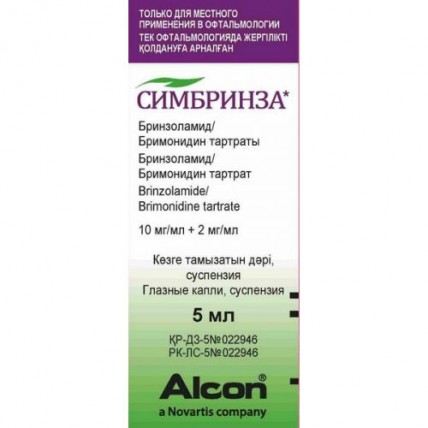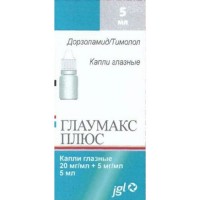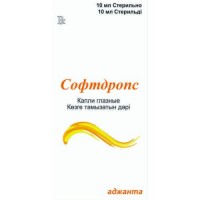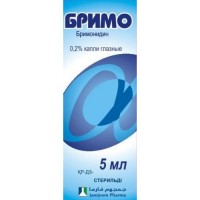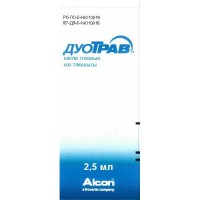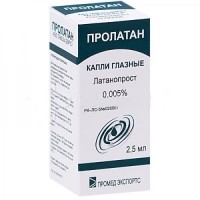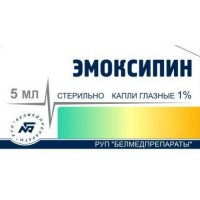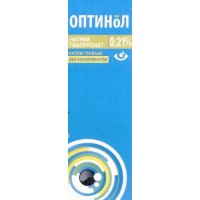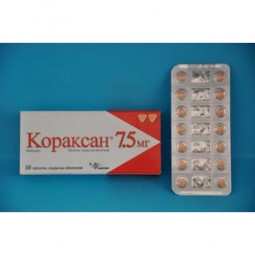Simbrinza eye drops 5 ml suspension
- $50.80
Sku:
419b55eff3da
The instruction for medical use of Simbrinza medicine * the Trade name of Simbrins * the International unlicensed name Is not present the Dosage form of the Drop eye, suspension, 5 ml contain Structure of 1 ml of drug: active agents: brinzolamid – 10.0 mg, a brimonidina tartrate – 2.0 mg, excipients: carbomer (974P), sodium chloride, Mannitolum, propylene glycol, tiloksapol, boric acid, a benzalkoniya chloride of 50% solution, sodium hydroxide and/or acid chlorohydrogen (for correction rn), the water purified. Description Uniform suspension of white or almost white color. Pharmacotherapeutic group Drugs for treatment of diseases of eyes. Protivoglaukomny drugs and miotik. Karboangidraza inhibitors. Brinzolamid in a combination with other drugs. The ATX S01EC54 code the Pharmacological Pharmacokinetics Absorption Later properties of topical administration in the form of eye drops brinzolamid is soaked up through a cornea in a system blood stream where strongly contacts karboangidrazy in erythrocytes. Its plasma concentration very low. Elimination half-life from blood long (& gt, 100 days), owing to binding with karboangidrazy in erythrocytes. Brimonidin is quickly soaked up after topical administration. In the researches in Vivo the maximum concentration in eyes was reached within less than 1 hour. The maximum concentration in plasma reached also lt, 1 ng/ml during & lt, 1 hour. Decrease in plasma levels with elimination half-life is about 2-3 hours. Cumulation cases at prolonged use were not. In a research of the topical ophthalmologic administration comparing system pharmacokinetics of the eye drops of Simbrins * applied twice or three times a day, in relation to a brinzolamid and a brimonidin, the same modes of dosing applied separately with use, in whole blood the combined drug and separately applied brinzolamid had a similar steady pharmacokinetics of a brinzolamid and N-dezetilbrinzolamida to that. Also, in a combination the brimonidin applied separately had a similar steady plasma pharmacokinetics of a brimonidin to that except for group of the drug Simbrinza * with use twice a day at which the average AUC0-12 value of hours was 25% lower, than at a brimonidin separately twice a day. Distribution In the researches in Vivo the maximum concentration of a brinzolamid in eyes after topical administration were observed in front fabrics, such as cornea, conjunctiva, intraocular liquid and irido-tsiliarny zone. Long presence of drug at tissues of an eye it is caused by binding of a karboangidraza. Brinzolamid moderately (about 60%) contacts proteins of plasma. Brimonidin has affinity with pigmentary eye fabrics, in particular, with an irido-tsiliarny zone, thanks to its known property to connect melanin. Data on safety show good tolerance and safety at prolonged use. Metabolism Brinzolamid is metabolized by hepatic isoenzymes of P450: CYP3A4, CYP2A6, CYP2B6 and CYP2C9. N-dezmetoksipropil and O-dezmetil are formed of primary metabolite of N-dezetilbrinzolamida, the same as O-desmetilbrinzolamida propyl-side chain – by oxidation is formed of other primary metabolite – N - an analog of N-propionic acid. Brimonidin is extensively metabolized by hepatic aldehyde oxidase with formation of the main metabolites of a 2-oksobrimonidin, 3-oksobrimonidin and 2.3-dioksobrimonidin. Also oxidizing splitting of imidazoline to 5-bromo-6-guanidinokhinoksalina is observed. Removal Brinzolamid is removed with urine in not changed look. In urine 60% and 6% of doses of a brinzolamid and N-dezetilbrinzolamida, respectively are defined. This received by in Vivo show some biliary excretion (about 30%), mainly metabolites. Brimonidin is brought mainly with urine in the form of metabolites. Metabolites in urine are defined by In Vivo in 60-75% of the oral or intravenously entered dose. Linearity/nonlinearity Pharmacokinetics of a brinzolamid is nonlinear because of saturated binding of a karboangidraza in whole blood and various fabrics. Steady exposure does not increase in a proportional and dose way. Brimonidin suppresses linear pharmacokinetics when exceeding clinical therapeutic level the Drug Simbrinza dosed Pharmakokinetiko-pharmakodinamichesky relationship * is intended for local action in an eye. Assessment of intraocular exposure at effective doses at the person is impossible. Pharmakokinetiko-pharmakodinamichesky relationship for decrease in the intraocular pressure (VGD) at the person is not established. Other special populations of Researches with the drug Simbrinza * by definition of influence of age, race, a renal or liver failure it was not carried out. Nevertheless, the combined drug is not recommended for patients with a heavy renal failure (clearance of creatinine & lt, 30 ml/min.). Cmax, AUC and elimination half-life of a brimonidin at elderly subjects (& gt, 65 years) and young adults similar. Influence of a renal and liver failure on system pharmacokinetics of a brimonidin was not estimated. Low system exposure of a brimonidin at topical ophthalmologic administration assumes clinically insignificant changes of exposure in plasma. Pediatric population System pharmacokinetics of a brinzolamid and brimonidin, separately or in a combination, at pediatric patients is not studied. A pharmacodynamics the action Mechanism Eye drops of Simbrins * contain two active components: brinzolamid and brimonidina tartrate. These two components reduce the intraocular pressure (VGD) at patients with an open angle glaucoma (OUG) and intraocular hypertensia (VGG), suppressing formation of intraocular liquid owing to tsiliarny processes in an eye. Though brinzolamid, and the brimonidin tartrate is reduced by VGD, suppressing formation of intraocular liquid, mechanisms of their action different. Brinzolamid acts by inhibition of enzyme of a karboangidraza (CA-II) in a tsiliarny epithelium that reduces education bicarbonate ions with the subsequent reduction of transport of sodium and liquid through a tsiliarny epithelium, and brings in a result to reduction of formation of intraocular liquid. Brimonidin, alfa-2 adrenergic agonist, inhibits enzyme adenylatecyclase and suppresses tsAMF-dependent formation of intraocular liquid. In addition, use of a brimonidin leads to increase in uveoskleralny outflow. Indications - decrease in the increased intraocular pressure (VGD) at patients with an open angle glaucoma or intraocular hypertensia at which monotherapy does not provide sufficient decrease in VGD the Route of administration and doses Only for topical ophthalmologic administration. The recommended dose – one drop of the drug Simbrinza * in the affected eye(s) two times a day. It is necessary to shake up a bottle before use. After use of drug the pressing of the lacrimonasal channel or careful cover a century for 2 minutes is recommended that reduces system absorption of drug. It reduces risk of development of system by-effects and increases local effect of drug. It is not necessary to touch with a pipette tip eyes, or any other surface to avoid pollution of contents of a bottle. After use to hold a bottle densely closed. The drug Simbrinza * can be used along with other ophthalmologic drugs of topical administration for decrease in VGD. At use more than one ophthalmologic drug of topical administration, it is necessary to observe an interval between burying at least 5 minutes. If the dose was passed, then treatment has to be continued with the dose following according to the schedule. The dose should not exceed 1 drop in the affected eye(s) 2 times a day. Side effects the Short overview of a profile of safety In clinical trials with participation of the drug Simbrinza *, used two times a day, the most frequent undesirable reactions were the eye hyperaemia and eye allergic reactions arising approximately at 6-7% of patients and a dysgeusia (bitterness or unusual taste in a mouth after burying) approximately at 3% of patients. The profile of safety of the drug Simbrinza * is similar to that at its separate components. Side effects during clinical trials using eye drops of Simbrins *, twice a day, and during clinical trials and post-marketing observation using separate components of a brinzolamid and a brimonidin were registered undesirable reactions stated below. They are classified according to the following symbol: very often (≥ 1/10), it is frequent (≥ 1/100 to & lt, 1/10), infrequently (≥1/1.000 to & lt, 1/100), is rare (≥1/10.000 to & lt, 1/1.000), is very rare (& lt, 1/10.000) or it is unknown (cannot be estimated on the basis of available data). Within each group the side reactions are provided in decreasing order of gravity. Often (≥ 1/100, & lt, 1/10) - sonlivost1, golovokruzheniye3, disgevziya1 - dryness in rtu1 - an allergy glaz1, keratit1, pain in glazakh1, discomfort in glazakh1, illegibility zreniya1, disturbance zreniya3, eye giperemiya1, blanching konjyunktivy3 Infrequently (≥ 1/1.000, & lt, 1/100) - nazofaringit2, faringit2, sinusit2 - reduced number eritrotsitov2, the increased amount of chloride in krovi2 - raised chuvstvitelnost3 - apathy, depressiya3, depressive sostoyaniye2, bessonnitsa1, decrease sexual vlecheniya2, night koshmary2, nervoznost2 - head bol1, a lack of coordination dvizheniy2, amneziya2, deterioration pamyati2, paresteziya2 - dispepsiya1, ezofagit2, gastrointestinal diskomfort1, diareya2, rvota2, toshnota2, frequent isprazhneniya2, meteorizm2, oral gipesteziya2, cavity paresthesias rta1 - atypical test of function pecheni2 - contact dermatit1, krapivnitsa2, syp2, makulo-papular syp2, an itching generalizovannyy2, alopetsiya2, the reduced turgor kozhi2 - an erosion rogovitsy1, swelled rogovitsy2, blefarit1, deposits in a cornea (precipitated calcium superphosphates) 1, conjunctival disorder (hillocks) 1, svetoboyazn1, fotopsiya2, swelled glaz2, swelled veka1, conjunctival swelled, dry glaz1, discharges from glaz1, decrease in sharpness zreniya2, raised slezotecheniye1, pterigium2, an erythema veka1, meybomianit2, diplopiya2, sensitivity to bright svetu2, a hypesthesia glaza2, pigmentation sklery2, subconjunctival kista2, unusual sensitivity in glazu1, astenopiya1 - golovokruzheniye1, a ring in ushakh2 - cardiorespiratory nedostatochnost2, stenokardiya2, aritmiya3, speeded up serdtsebiyeniye2.3, disturbance cordial ritma2, bradikardiya2.3, takhikardiya3 - gipotenziya1 - dispnoe2, bronchial giperaktivnost2, pharyngolaryngeal bol2, dryness in gorle1, kashel2, nasal krovotecheniye2, congestion upper respiratory putey2, congestion nosa1, rinoreya2, irritation in gorle2, dryness mucous nosa1, post-nasal zatyok1, chikhaniye2 - pain in poyasnitse2, muscular spazmy2, mialgiya2 - renal bol2 - erectile disfunktsiya2 - bol2, discomfort in chest kletke2, atypical oshchushcheniya2, feeling trevogi2, razdrazhimost2, the rest preparata1 Is very rare (& lt, 1/10.000) - obmorok3 - uveit3, mioz3 - gipertenziya3 It is unknown - rinit2 - tremor2, gipesteziya2, agevziya2 - swelled litsa3, dermatit2.3, eritema2.3 - visual rasstroystva2, madaroz2 - astma2 - artralgiya2, pain in konechnosti2 - pollakiuriya2 - pain in grudi2, the peripheral otyok2,3 1 undesirable reaction observed using eye drops of Simbrins * 2 additional undesirable reaction observed using monotherapy brinzolamidy 3 additional undesirable reaction, observed using monotherapy brimonidiny the Description of separate undesirable reactions the Dysgeusia was the most frequent system undesirable reaction connected with drug Simbrinza use * (3.4%). Perhaps, it is caused by hit of eye drops in a nasopharynx via the lacrimonasal channel and, mainly, is connected with a component brinzolamid. Lacrimonasal occlusion or accurate cover of a century after burying can help to reduce emergence of this reaction. The drug Simbrinza * is contained brinzolamid which is sulfanamide inhibitor of a karboangidraza with system absorption. Impact on digestive tract, nervous system, hematologic, renal and metabolic reactions, mainly, are connected with system inhibitors of a karboangidraza. The same type of the undesirable reactions caused by oral inhibitors of a karboangidraza can arise at topical administration. The undesirable reactions which are usually connected with a component brimonidin the drug Simbrinza * include development of eye allergic types of reaction, fatigue and/or drowsiness and dryness in a mouth. Use of a brimonidin was connected with the minimum lowerings of arterial pressure. Some patients who applied eye drops of Simbrins * experienced the lowering of arterial pressure similar to what was observed at use of a brimonidin as monotherapy. Contraindications - hypersensitivity to active or to excipients, or to sulfonamides, - the patients receiving drug with monoamine oxidase inhibitor (MAO) - patients on antidepressants which worsen noradrenergichesky transfer (for example, tricyclic antidepressants and mianserin), - patients with a heavy renal failure, - patients with giperkhloremichesky acidosis - to newborns and children up to 8 (eight) years Medicinal interactions Specific researches of interaction of drugs with eye drops of Simbrins * were not conducted. Monoamine oxidase inhibitors and tricyclic antidepressants the Drug Simbrinza * is contraindicated to the patients accepting monoamine oxidase inhibitors and antidepressants which worsen noradrenergichesky transfer (for example, tricyclic antidepressants and mianserin). Tricyclic antidepressants can reduce eye hypotensive reaction of the drug Simbrinza*. A central nervous system depressants Should be applied with care because of possible additive or exponential effect with a central nervous system depressants (for example, alcohol, barbiturates, opiates, sedative or anesthetics). Any data on level of the circulating catecholamines after use of eye drops of Simbrins * are absent. However it is necessary to apply with care at the patients using medicines which can negatively influence metabolism and absorb the circulating amines (for example, Chlorpromazinum, methylphenidate, reserpine, inhibitors of the return capture of serotonin noradrenaline). Hypotensive/cardiac glycosides Alpha and adrenergic agonists (for example, a brimonidina tartrate) as a class, pulse and arterial blood pressure can reduce. At several patients the small lowering of arterial pressure as a result of drug Simbrinza* use was observed. It is necessary to use with care drug at simultaneous use of such medicines as hypotensive drugs and/or cardiac glycosides. It is necessary to apply with care at introduction (or change of a dose) the accompanying system medicines (irrespective of a dosage form) which can interact with α-adrenergic agonists or their activities, i.e. agonists or antagonists of an adrenergic receptor interfere (for example, izoprenalin, Prazozinum). Oral inhibitors of a karboangidraza Brinzolamid is an inhibitor of a karboangidraza, and, despite topical administration, it is soaked up systemically. Disturbances of acid-base equilibrium were registered at intake of oral inhibitors of a karboangidraza. It is necessary to consider risk of interaction at the patients accepting eye drops of Simbrinza*. There is a probability of additive impact on the known system influence of inhibition of a karboangidraza at the patients accepting oral inhibitor of a karboangidraza and brinzolamid topical administration. Simultaneous use of eye drops of Simbrins * and oral inhibitors of a karboangidraza is not recommended. CYP3A4 inhibitors Isoenzymes of P-450 cytochrome, including CYP3A4 (main), CYP2A6, CYP2B6, CYP2C8 and CYP2C9, are responsible for metabolism of a brinzolamid. It is supposed that CYP3A4 inhibitors, such as ketokonazol, itrakonazol, Clotrimazolum, ritonavir and troleandomitsin will inhibit metabolism of a brinzolamid by means of CYP3A4. The care at the accompanying use of CYP3A4 inhibitors is necessary. However, accumulation of a brinzolamid is improbable as generally he is brought from an organism mainly through kidneys. Br
nzolamid is not inhibitor of isoenzymes of P-450 cytochrome. The special instructions Medication it should not be administered in the form of an injection. It is impossible to swallow of eye drops of Simbrinza*. Influence approximately the Drug Simbrinza * was not investigated at patients with closed-angle glaucoma, and its use for such patients is not recommended. The possible role of a brinzolamid as an endothelium of a cornea is not studied at patients with the damaged cornea (in particular, at patients with low quantity of endothelial cells). Especially, the patients carrying contact lenses were not investigated, and observation at such patients at use of a brinzolamid as inhibitors of a karboangidraza can negatively influence hydration of a cornea is recommended carefully, and carrying contact lenses can increase risk for a cornea. Careful observation of patients with the damaged cornea, having diabetes or having cornea dystrophy is recommended. Brimonidina tartrate can cause eye allergic reactions. If such reactions are observed, treatment should be interrupted. Eye delayed-type hypersensitivity reactions were registered at use of a brimonidin of tartrate, some of them were associated with the raised VGD. Potential impact of the termination of use of eye drops of Simbrins * was not studied. As duration VGD-snizhayushchego of effect of the drug Simbrinza * was not investigated, the expected effect of a brinzolamid is 5-7 days. VGD-snizhayushchy the effect of a brimonidin can be longer. Allergic reactions to sulfonamide Eye drops of Simbrins * contain systemic action brinzolamid, sulphonamide inhibitor of a karboangidraza and, despite topical administration, is soaked up systemically. Some types of undesirable reactions of streptocides can arise also at topical administration. In case of development of symptoms of serious reactions or hypersensitivity the use of this medicine should be interrupted. Disturbances from heart After use of eye drops of Simbrins * at some patients the small lowering of arterial pressure was observed. It is necessary to use with care hypotensive drugs and/or cardiac glycosides along with eye drops of Simbrins * and also at patients with a serious or unstable and uncontrollable cardiovascular illness. Eye drops of Simbrins * should be applied with care at patients with a depression, insufficiency of cerebral or coronary circulation, Reynaud's phenomenon, orthostatic hypotension or an obliterating thromboangitis. Disturbances of acid-base equilibrium of Disturbance of acid-base equilibrium were registered at intake of oral inhibitors of a karboangidraza. Eye drops of Simbrins * contain brinzolamid, karboangidraza inhibitor, and, despite topical administration, is soaked up systemically. At topical administration there can be same types of undesirable reactions inherent to oral carboxylic inhibitors (i.e. disturbances of acid-base equilibrium). To Apply disturbances from kidneys with care at patients with risk of a renal failure because of possible risk of a metabolic acidosis. Eye drops of Simbrins * are contraindicated to patients with a heavy renal failure. An abnormal liver function Eye drops of Simbrins * were not investigated at patients with an abnormal liver function, at treatment of such patients drug should be used with care. Concentration of attention Oral inhibitors of a karboangidraza can worsen ability to carry out the tasks demanding concentration of attention and/or physical coordination from patients of advanced age. Eye drops of Simbrins * are soaked up systemically and, therefore, it can arise at topical administration. Benzalkony chloride Eye drops of Simbrins * contain benzalkony chloride which can cause irites, irritation of eyes and, as we know, to decolour soft contact lenses. It is necessary to avoid contact with soft contact lenses. Patients should know that before use of eye drops of Simbrins * it is necessary to remove contact lenses and to wait not less than 15 minutes before reuse. Benzalkony chloride is also known for ability to cause a dot keratitis and/or a toxic ulcer keratopathy. Careful observation at frequent or prolonged use of drug is required. It is not applied at children up to 8 years. Use in pediatrics Safety and efficiency of eye drops of Simbrins * at children and teenagers aged from 8 up to 17 years was not established. Symptoms of overdose of a brimonidin (including a loss of consciousness, hypotension, hypotonia, bradycardia, a hypothermia, cyanosis and an apnoea) were registered at the newborns and children accepting eye drops with brimonidiny as a part of therapeutic treatment of congenital glaucoma. Thus, eye drops of Simbrins * are contraindicated to children up to 8 years. Treatment of children of 8 years is also more senior is contraindicated because of the probability of emergence of side effects from outside the central nervous system. Pregnancy and the period of breastfeeding Pregnancy Are absent or pregnant women have a limited amount of data on use of eye drops of Simbrins *. Brinzolamid was teratogenic after system use of in Vivo. The researches in Vivo with oral administration of a brimonidin do not indicate the open harmful effects connected with reproductive toxicity. In the researches in Vivo brimonidin got into a placenta and got to blood circulation of a fruit in limited degree. Eye drops of Simbrins * are not recommended for inclusion in time of pregnancy and at the women of childbearing age who are not using contraception. Breastfeeding Is unknown whether eye drops of Simbrins * are allocated at topical administration in maternal milk. Available pharmakodinamichesky/toxicological data show that as a result of oral administration of in Vivo in breast milk the minimum levels of a brinzolamid are distinguished. Brimonidin applied orally is allocated in breast milk. Eye drops of Simbrins * should not be used at women in the period of a lactation. Fertility Preclinical data do not show any impact of a brinzolamid or a brimonidin on fertility. There are no data on impact of topical ophthalmologic administration of eye drops of Simbrins * on reproductive function. Features of influence of medicine on ability to run the vehicle or potentially dangerous mechanisms Eye drops of Simbrins * make moderate impact on ability of driving of vehicles and control of mechanisms. Eye drops of Simbrins * can cause dizziness, fatigue and/or drowsiness that can worsen ability of driving of vehicles and control of mechanisms. The temporary illegibility of sight or other visual disorders can affect ability of driving by the vehicle or controls of mechanisms. If when burying there is an indistinct sight, the patient has to wait before clearing of sight, before driving or control of mechanisms. Oral inhibitors of a karboangidraza can worsen ability at patients of mature age to carry out the tasks demanding concentration of attention and/or physical coordination. Overdose the Electrolytic imbalance, development of an atsidotichesky state and potential impacts on nervous system can arise after overdose of a brinzolamid. It is necessary to control levels of electrolytes in serum (especially potassium) and the blood pH level. There is very limited information on accidental ingestion of a brimonidin at adults, only such undesirable phenomenon as hypotension is registered. Symptoms of overdose of a brimonidin at inadvertent ingestion were registered at pediatric patients. Central nervous system depression symptoms, a typical temporary coma or weak consciousness, a lethargy, drowsiness, hypotonia, bradycardia, a hypothermia, pallor, respiratory depression and an apnoea were observed. All reportirovanny subjects received complete recovery, within 6-24 hours. Treatment of oral overdose includes the supporting and symptomatic therapy, the free passability of airways has to be maintained. At accidental and deliberate overdose it is necessary to see a doctor. The form of release and packing On 5 ml of suspension place in an opaque cylindrical bottle from polyethylene of low density with the doser and the polypropylene screw-on cap like "drop-teyner" of white color. On 1 bottle together with the instruction for medical use in the state and Russian languages place in a cardboard pack. To Store storage conditions at a temperature not above 30 °C. To store out of children's reach! A period of storage 2 years the Expiration date after the first opening – 4 weeks. Not to apply after an expiration date. Prescription status According to the prescription the Name and the address of the manufacturing organization of page and. Alkon-Kuvrer of N of century, Belgium Rijksweg 14, B-2870 Puurs, Belgium the Name and the address of the holder of the registration certificate of Novartis Pharm AG, Switzerland the Address of the organization accepting claims from the consumer on quality of a product (goods) and Filial Novartis Pharm Servisez AG, responsible for post-registration observation of safety of medicine in the territory of the Republic of Kazakhstan, in Kazakhstan 050051 Almaty, Luganskogo St., 96 ph.: (727) 258-24-47 fax: (727) 244-26-51
To develop
nzolamid is not inhibitor of isoenzymes of P-450 cytochrome. The special instructions Medication it should not be administered in the form of an injection. It is impossible to swallow of eye drops of Simbrinza*. Influence approximately the Drug Simbrinza * was not investigated at patients with closed-angle glaucoma, and its use for such patients is not recommended. The possible role of a brinzolamid as an endothelium of a cornea is not studied at patients with the damaged cornea (in particular, at patients with low quantity of endothelial cells). Especially, the patients carrying contact lenses were not investigated, and observation at such patients at use of a brinzolamid as inhibitors of a karboangidraza can negatively influence hydration of a cornea is recommended carefully, and carrying contact lenses can increase risk for a cornea. Careful observation of patients with the damaged cornea, having diabetes or having cornea dystrophy is recommended. Brimonidina tartrate can cause eye allergic reactions. If such reactions are observed, treatment should be interrupted. Eye delayed-type hypersensitivity reactions were registered at use of a brimonidin of tartrate, some of them were associated with the raised VGD. Potential impact of the termination of use of eye drops of Simbrins * was not studied. As duration VGD-snizhayushchego of effect of the drug Simbrinza * was not investigated, the expected effect of a brinzolamid is 5-7 days. VGD-snizhayushchy the effect of a brimonidin can be longer. Allergic reactions to sulfonamide Eye drops of Simbrins * contain systemic action brinzolamid, sulphonamide inhibitor of a karboangidraza and, despite topical administration, is soaked up systemically. Some types of undesirable reactions of streptocides can arise also at topical administration. In case of development of symptoms of serious reactions or hypersensitivity the use of this medicine should be interrupted. Disturbances from heart After use of eye drops of Simbrins * at some patients the small lowering of arterial pressure was observed. It is necessary to use with care hypotensive drugs and/or cardiac glycosides along with eye drops of Simbrins * and also at patients with a serious or unstable and uncontrollable cardiovascular illness. Eye drops of Simbrins * should be applied with care at patients with a depression, insufficiency of cerebral or coronary circulation, Reynaud's phenomenon, orthostatic hypotension or an obliterating thromboangitis. Disturbances of acid-base equilibrium of Disturbance of acid-base equilibrium were registered at intake of oral inhibitors of a karboangidraza. Eye drops of Simbrins * contain brinzolamid, karboangidraza inhibitor, and, despite topical administration, is soaked up systemically. At topical administration there can be same types of undesirable reactions inherent to oral carboxylic inhibitors (i.e. disturbances of acid-base equilibrium). To Apply disturbances from kidneys with care at patients with risk of a renal failure because of possible risk of a metabolic acidosis. Eye drops of Simbrins * are contraindicated to patients with a heavy renal failure. An abnormal liver function Eye drops of Simbrins * were not investigated at patients with an abnormal liver function, at treatment of such patients drug should be used with care. Concentration of attention Oral inhibitors of a karboangidraza can worsen ability to carry out the tasks demanding concentration of attention and/or physical coordination from patients of advanced age. Eye drops of Simbrins * are soaked up systemically and, therefore, it can arise at topical administration. Benzalkony chloride Eye drops of Simbrins * contain benzalkony chloride which can cause irites, irritation of eyes and, as we know, to decolour soft contact lenses. It is necessary to avoid contact with soft contact lenses. Patients should know that before use of eye drops of Simbrins * it is necessary to remove contact lenses and to wait not less than 15 minutes before reuse. Benzalkony chloride is also known for ability to cause a dot keratitis and/or a toxic ulcer keratopathy. Careful observation at frequent or prolonged use of drug is required. It is not applied at children up to 8 years. Use in pediatrics Safety and efficiency of eye drops of Simbrins * at children and teenagers aged from 8 up to 17 years was not established. Symptoms of overdose of a brimonidin (including a loss of consciousness, hypotension, hypotonia, bradycardia, a hypothermia, cyanosis and an apnoea) were registered at the newborns and children accepting eye drops with brimonidiny as a part of therapeutic treatment of congenital glaucoma. Thus, eye drops of Simbrins * are contraindicated to children up to 8 years. Treatment of children of 8 years is also more senior is contraindicated because of the probability of emergence of side effects from outside the central nervous system. Pregnancy and the period of breastfeeding Pregnancy Are absent or pregnant women have a limited amount of data on use of eye drops of Simbrins *. Brinzolamid was teratogenic after system use of in Vivo. The researches in Vivo with oral administration of a brimonidin do not indicate the open harmful effects connected with reproductive toxicity. In the researches in Vivo brimonidin got into a placenta and got to blood circulation of a fruit in limited degree. Eye drops of Simbrins * are not recommended for inclusion in time of pregnancy and at the women of childbearing age who are not using contraception. Breastfeeding Is unknown whether eye drops of Simbrins * are allocated at topical administration in maternal milk. Available pharmakodinamichesky/toxicological data show that as a result of oral administration of in Vivo in breast milk the minimum levels of a brinzolamid are distinguished. Brimonidin applied orally is allocated in breast milk. Eye drops of Simbrins * should not be used at women in the period of a lactation. Fertility Preclinical data do not show any impact of a brinzolamid or a brimonidin on fertility. There are no data on impact of topical ophthalmologic administration of eye drops of Simbrins * on reproductive function. Features of influence of medicine on ability to run the vehicle or potentially dangerous mechanisms Eye drops of Simbrins * make moderate impact on ability of driving of vehicles and control of mechanisms. Eye drops of Simbrins * can cause dizziness, fatigue and/or drowsiness that can worsen ability of driving of vehicles and control of mechanisms. The temporary illegibility of sight or other visual disorders can affect ability of driving by the vehicle or controls of mechanisms. If when burying there is an indistinct sight, the patient has to wait before clearing of sight, before driving or control of mechanisms. Oral inhibitors of a karboangidraza can worsen ability at patients of mature age to carry out the tasks demanding concentration of attention and/or physical coordination. Overdose the Electrolytic imbalance, development of an atsidotichesky state and potential impacts on nervous system can arise after overdose of a brinzolamid. It is necessary to control levels of electrolytes in serum (especially potassium) and the blood pH level. There is very limited information on accidental ingestion of a brimonidin at adults, only such undesirable phenomenon as hypotension is registered. Symptoms of overdose of a brimonidin at inadvertent ingestion were registered at pediatric patients. Central nervous system depression symptoms, a typical temporary coma or weak consciousness, a lethargy, drowsiness, hypotonia, bradycardia, a hypothermia, pallor, respiratory depression and an apnoea were observed. All reportirovanny subjects received complete recovery, within 6-24 hours. Treatment of oral overdose includes the supporting and symptomatic therapy, the free passability of airways has to be maintained. At accidental and deliberate overdose it is necessary to see a doctor. The form of release and packing On 5 ml of suspension place in an opaque cylindrical bottle from polyethylene of low density with the doser and the polypropylene screw-on cap like "drop-teyner" of white color. On 1 bottle together with the instruction for medical use in the state and Russian languages place in a cardboard pack. To Store storage conditions at a temperature not above 30 °C. To store out of children's reach! A period of storage 2 years the Expiration date after the first opening – 4 weeks. Not to apply after an expiration date. Prescription status According to the prescription the Name and the address of the manufacturing organization of page and. Alkon-Kuvrer of N of century, Belgium Rijksweg 14, B-2870 Puurs, Belgium the Name and the address of the holder of the registration certificate of Novartis Pharm AG, Switzerland the Address of the organization accepting claims from the consumer on quality of a product (goods) and Filial Novartis Pharm Servisez AG, responsible for post-registration observation of safety of medicine in the territory of the Republic of Kazakhstan, in Kazakhstan 050051 Almaty, Luganskogo St., 96 ph.: (727) 258-24-47 fax: (727) 244-26-51
To develop
